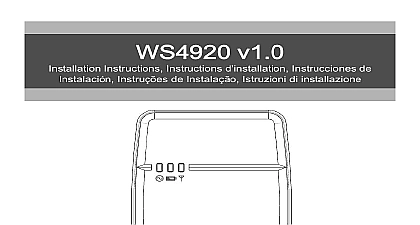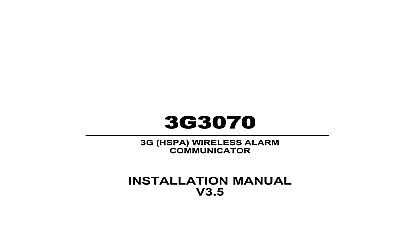DSC WS4933 Installation Manual - R002 - En-Fr-Es-Po

File Preview
Click below to download for free
Click below to download for free
File Data
| Name | dsc-ws4933-installation-manual-r002-en-fr-es-po-3048971625.pdf |
|---|---|
| Type | |
| Size | 1.55 MB |
| Downloads |
Text Preview
WS4933 433MHz Wireless Carbon Monoxide Detector and Operating Instructions these instructions thoroughly before installation and use of the WS4933 of combustion It is not designed to detect smoke fire or other gases the product has been investigated and determined to comply with applic requirements 1 Wireless CO Detector WS4933 is designed to monitor the CO gas level in residential dwellings and give warning before dangerous levels are detected This device is intended to be used a compatible wireless alarm system The detector consists of an electrochemical monoxide sensor assembly coupled to a wireless transmitter Wireless Carbon Monoxide Alarm communicates with the control panel and can alarm tamper and battery condition messages to the system receiver The detector expiry date is stamped on the detector After the expiry date detector should not be used do not wait for end of life indication Unauthorized removal of the unit from the mounting bracket will a tamper alert WS4933 wireless Carbon Monoxide detector shall be installed and used within an that provides the pollution degree max 2 and overvoltages category II in non hazardous locations only The equipment is designed to be installed by persons only skilled person is defined as a person with relevant education or to enable him or her to identify hazards and to take appropriate actions to the risks of injury to themselves and others to properly install test and maintain a CO detector may cause it to fail res in loss of life Installation of the CO detector should not be used as a substitute proper installation use and maintenance of fuel burning appliances including ventilation and exhaust systems carbon monoxide detector is designed for indoor use only Do not expose it to or moisture Do not knock or drop the detector Do not open or tamper with the as this could cause malfunction The detector will not protect against the risk carbon monoxide poisoning if not properly installed This device will only indicate the presence of carbon monoxide gas the sensor Carbon monoxide gas may be present in other areas This carbon alarming device is designed to detect carbon monoxide gas from any Alarm LED see Table 1 for LED indications Tamper release opening Test Hush button Battery compartment Breakaway tab see Figure 3 Instructions Installation replace the battery Remove the detector from its mounting base by twisting it counterclockwise and dispose of the battery according to your local regulations To ensure proper power down sequence wait a minimum of 20 seconds before the new battery a new 3 volt CR123A Panasonic lithium battery in the battery com observing the correct polarity If the battery is incorrectly inserted gently with a flathead screwdriver and correctly reinsert Reinstall the detector onto the mounting bracket by turning it clockwise After the power up sequence the green LED blinks once every 12 seconds to normal operation If the battery is not installed correctly the detector not operate and the battery may be damaged the alarm control panel program the 6 digit serial number of the WS4933 located the back of the detector Please refer to your control panel installation manual for a Location a suitable location is critical for the CO detector The Consumer Product Commission CPSC recommends to use at least one CO detector per house located as near as possible to sleeping areas of the home because the human is most vulnerable to the effects of CO gas during sleeping hours 2 CO Detector Placement Bedroom Living Room Kitchen Basement Garage added protection install additional CO detectors in every bedroom and on every of your home If your bedroom hallway is longer than 14 meters 40 feet install CO detector at BOTH ends of the hallway Install an additional detector 6 meters feet away from the furnace or fuel burning heat source For maximum protection detector should also be located outside primary sleeping areas or at each level of home Mount the detector on a firm wall or ceiling NOT install CO detectors locations where temperature may be below 0 14 or above 40 104 locations where humidity is below 10 or above 93 RH non condensing Near paint thinner fumes Near air conditioners furnaces stoves fireplaces and any other ventilation source may interfere with CO gas entering the detector locations where furniture or draperies may obstruct the air flow exhaust streams from gas engines vents flues or chimneys Where dirt or dust could collect and block the sensor and prevent it from working locations that can be reached by children turbulent air from ceiling fans close proximity to an automobile exhaust pipe this will damage the detector detector can be mounted on a wall or ceiling For EN approved sites only ceiling is allowed CO detector must be mounted with its bracket when it is attached to its bracket tamper switch is pressed and the detector automatic reset is performed Refer to Figure 3 and install using screw locations as required Maneuver the bracket so the screws are at the elbow of the screw slots and secure Fit the detector inside the mounting bracket by aligning it as shown in Figure 3 alignment notch should be slightly offset from the mounting bracket release tab then turn the detector in a clockwise direction until it clicks place Test the detector after completing the installation as described in the Testing the section of this manual and refer to the alarm control panel installation for additional information concerning the use of wireless devices 3 Mounting the Detector Protection WS4933 includes a tamper resistant feature that prevents removal from the mount bracket without the use of a tool To engage the tamper resistant feature cut the breakaway tab marked E in Figure 3 located on the mounting bracket and then the detector To remove the detector from the mounting bracket once it has been tamper resistant insert an appropriate tool into the tamper release opening loc on the detector housing marked B in Figure 1 Press and hold while sim turning the detector counterclockwise Instructions the CO Detector Performing a CO detector system test will generate an alarm trans Notify the central station before testing a CO detector system test by pressing the Test Hush button for a minimum of seconds the red LED flashes and the sounder emits a temporal 4 pattern a CO detector local test by pressing the Test Hush button for a minimum of 2 the sounder will emit 2 short beeps the detector weekly to ensure proper operation of the detector When low battery indicated see Table 1 and Specifications immediately replace the battery Once a use a vacuum cleaner to keep the air vents free of dust and Visual Indications tri colored LED green yellow red and a sounder on the detector provide local and audible indication of the detector status as listed in Table 1 The sounder and LED are not synchronized 1 Detector Status and Indication flash every 12 flash every 12 flash every 6 Battery Yellow flash every seconds End Life up flash every seconds yellow red sequence every seconds yellow red sequence every seconds S3.41 temporal 4 press to hush for 5 minutes 100ms chirp every 45 100ms chirp every 45 press button to hush for hours 100ms chirp every 45 100ms chirp at end of sequence of life frequency signal temporal 4 tone current range humidity range messages source supervision life expectancy battery threshold battery years see date stamped on back of detector dBA min in alarm at 10ft 3m to 37.8 40 to 100 to 95 Relative Humidity non condensing gas alarm as a result of sensor end of life or trouble supervision 3 volt CR123A Panasonic lithium battery transmission of battery status data as of any transmitted message years under typical use NOTE Constant to temperature or humidity extremes reduce battery life V you should know about Carbon Monoxide monoxide also known as CO by the chemical form is a highly dangerous gas because it is colorless


